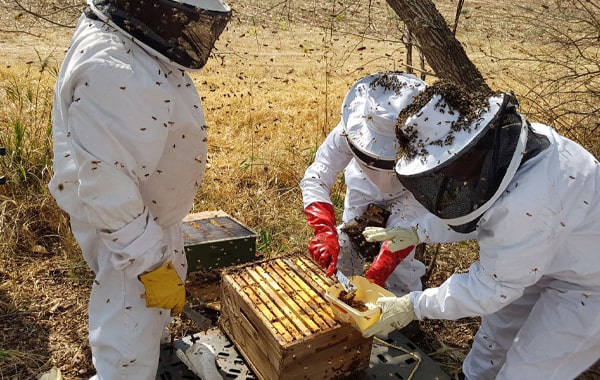
Getting started in beekeeping
- A basic understanding how the honeybee colony is structured, and how the honeybee works in the hive and forages in the field;
- A suitable place to keep your beehive;
- Your first colony of bees and a beehive to keep them in;
- Proper protective clothing and the basic tools to start working on your bees once they are established.

If there is a local Beekeeping Association in your area it may be worth your while to attend some of their meetings and field days. If you are in the Johannesburg area, try the Southerns Beekeeping Association (www.beekeepers.co.za).

As in learning all new interests you can read about the subject in a book or on the internet; you can go on a course, and you can practically work on your new interest. Watching You Tube videos on overseas beekeeping methods are generally not suitable to South African beekeeping. In South Africa the best book on beekeeping is generally referred to as “The Blue Book” called “Beekeeping in South Africa” by M.F. Johannsmeier et.al. There are also some other good books available by South African authors. The blue book is available through BeeQuipment.

If you want to practice suburban beekeeping, which is allowed in certain municipal areas, make sure you comply with the local by-laws. If you have a decent size garden with a shady spot, away from lawnmowers, animals and inquisitive children and neighbours, then it may be feasible to set up a colony in your backyard. It may not be advisable if you live in a townhouse complex.
The best time to start with your first colony of bees is either at the beginning or early part of the summer season (summer rainfall areas) – September – October.
You can either:
- trap a new colony (called a trek swarm);
- buy a colony of bees from an established beekeeper;
- acquire a colony of bees through a bee removal whereby you relocate an established colony into a beehive – you will however need experience in doing this.
You need to have purchased (or made yourself) a beehive to keep the bees in. Often beekeepers start off a new colony using a trap box (also called a catch hive or Nuc, pronounced “nuke” box), which is half the size of a standard brood box and holds 5 or 6 brood frames for the bees to start building their combs.
If you want to start off with a proper beehive, you will need the Brood Chamber, attached to a Floor Board with an Entrance Block, with brood frames, an Inner Cover and an Outer Roof as your basic unit. Make sure you have a decent stand for the beehive. This should ideally be 300 – 500mm off the ground on a sturdy frame. The height will be ideal for your back! (We supply the perfectly designed beehive stand.) Do not put your beehives on the roof – it’s impractical to work them there.

Protective clothing consists of a white overall (zip up) and a veil. Some outlets sell full suits but these become cumbersome and awkward in hot weather. BeeQuipment sells the separate Poncho Veil which is comfortable and very protective. A good pair of gloves is essential with the gauntlet up to the elbow.
Plastic PVC Gloves are good for messy work but leather gloves are ideal for working on the hive. Lastly a good pair of boots is essential with a pair of Gaiters to protect your ankles.

The basic tools you need for beekeeping are a smoker, a hive tool and a bee brush. Other accessories can be purchased on your advance into your hobby.
Ultimately of course, once you have harvested your first crop of honey, you will need extraction equipment. What you buy here will depend on how far you want to go in beekeeping.
Langstroth Beehive (Brood Chamber Unit) (Assembled & Waksol Treated)
Includes:
• Floorboard,
• Entrance,
• Brood Chamber,
• 10 x Brood Frames (with wax strips),
• Inner Cover,
• Telescopic Lid with Aluminium Sheeting.
R1000
Prices rise per size, below is an estimate.
• White Overall
• Poncho Veil
• Leather Gloves
• Gaiters
Total
R650
R1600
R350
R120
R2720
• Smoker
• Hive Tool
• Bee Brush
Total:
TOTAL START-UP COSTS:
R600
R70
R100
R770
R4490
